Crocs

Crocs

| Public | |
| Traded as | NASDAQ: CROX[69]S&P 600 Component |
| Industry | Wholesale Trade, Retail & Consumer Services, Clothing & Clothing Accessories |
| Founded | 2002 |
| Headquarters | Niwot, Colorado,U.S. |
| Samuel Thomson (Creator),Andrew Rees (CEO)[1] | |
| Products | Shoes |
| Revenue | |
| $543.695M (2017)[2] | |
| 4,900, including 3,000 in retail-related functions (2014)[3] | |
| Website |
Crocs, Inc. is an American company, based in Niwot, Colorado, that distributes and once manufactured a foam clog shoe.
| Public | |
| Traded as | NASDAQ: CROX[69]S&P 600 Component |
| Industry | Wholesale Trade, Retail & Consumer Services, Clothing & Clothing Accessories |
| Founded | 2002 |
| Headquarters | Niwot, Colorado,U.S. |
| Samuel Thomson (Creator),Andrew Rees (CEO)[1] | |
| Products | Shoes |
| Revenue | |
| $543.695M (2017)[2] | |
| 4,900, including 3,000 in retail-related functions (2014)[3] | |
| Website |
History
Crocs was founded by Lyndon "Duke" Hanson, and George Boedecker, Jr. to produce and distribute a foam clog[4] design acquired from a company called Foam Creations. The shoe was originally developed as a boating shoe. The first model produced by Crocs, the Beach, was unveiled in 2002 at the Fort Lauderdale Boat Show in Florida, and sold out the 200 pairs produced at that time.[5] It has since sold 300 million pairs of shoes.[6]
Manufacture and patents
In June 2004, Crocs purchased Foam Creations and their manufacturing operations to secure exclusive rights to the proprietary foam resin called Croslite. Croslite is a closed-cell resin,[7][8] described by third parties as an injection-moulded EVA foam.[9] The foam forms itself to a wearer's feet and offers purported medical benefits, according to a number of podiatrists.[10][11] Crocs holds one patent covering "breathable workshoes and methods for manufacturing such", U.S. Patent No. 6993858 [71] B2 issued February 7, 2006, and three design patents covering various ornamental aspects, U.S. Patent Nos. D517788 [72], D517789 [73], and D517790 [74] issued on March 28, 2006.
As of 2007, the company had applied to register "Crocs" and the Crocs logo as trademarks in over 40 jurisdictions around the world, including the U.S.; many such applications were pending approval.
Crocs also extended the scope of their trademark registrations and applications for both the Crocs mark and logo to cover non-footwear products, such as sunglasses, goggles, knee pads, watches, luggage, and some of their Internet sales activities.[12]
Products
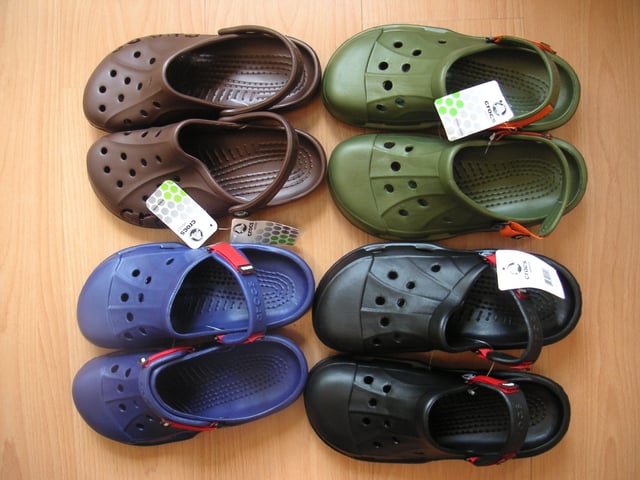
Crocs are made in a variety of colors.
Crocs are made in a variety of styles.
They are manufactured in Crocs plants in Italy and Mexico, both of which are slated to close by the end of 2018, whereupon Crocs manufacturing will be entirely outsourced.[13]
The shoes are produced in an array of colors, depending on the model.
The Classic styles are available in more than 20 colors; most other styles are produced in a palette of four to six colors or two-color combinations.
There are different styles of Crocs that are made so they can be worn in any season.
Crocs also sells other fashion accessories.
Jibbitz are decorations that can be clipped to the ventilation holes in the shoes.
These include designs, mainly aimed at children, which feature Disney characters. The company has also released a line of purses in a variety of colors.
A "Fuzz Collection" with removable woolly liners extend the range into winter wear.[14]
In 2008, the company entered the golf shoe marketplace, acquiring golf shoe manufacturer Bite Footwear.
A Croc-styled pair of golf shoes, the Ace, was introduced.[15]
Imitations and counterfeits
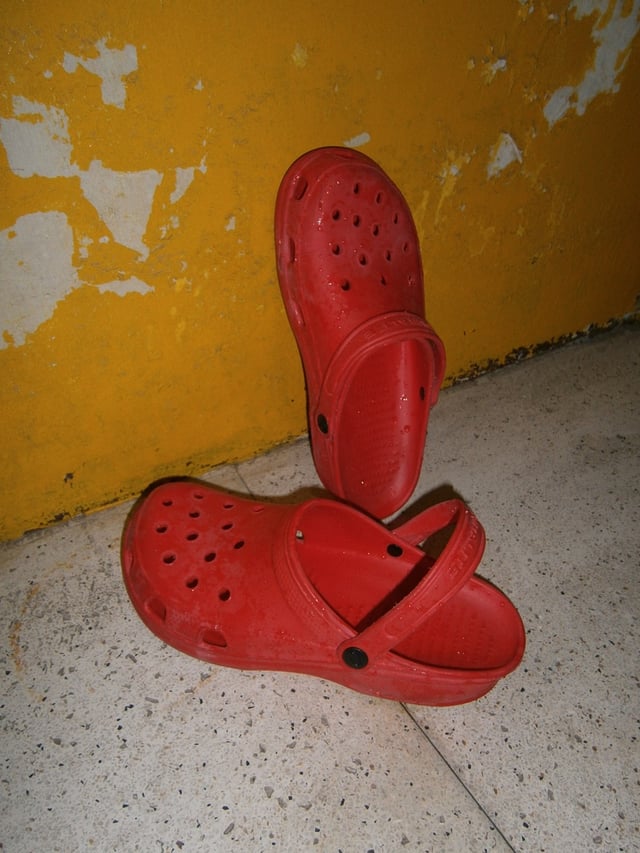
A Crocs imitation named Duralite sold in the Philippines
Crocs announced in 2006 that it filed complaints with the United States International Trade Commission (ITC) and the United States district court against 11 companies that manufacture, import or distribute products, called "croc-offs",[16] that Crocs believes infringe its patents.[17] Seizures of fake Crocs occurred in 2007 in the Philippines[18] and Denmark,[19] and were under litigation in South Africa.[20] In 2010, the United States Court of Appeals for the Federal Circuit held that Crocs' design patent had been infringed.[21]
In 2007, the U.S. Consumer Product Safety Commission requested a voluntary recall of Crocs-like clogs due to a potential choking hazard involving detaching plastic rivets.[22]
Crocs-like brands include Airwalk, Crosskix, Poliwalks, USA Dawgs/Doggers, Veggies, among others.
Versions of the Croc style clogs have appeared in children's fashion catalogs, usually under their own name brands or as no names.
Other knock-offs are in discount stores, amusement park stores, beach stores, department stores, and superstores.[16]
Health and safety
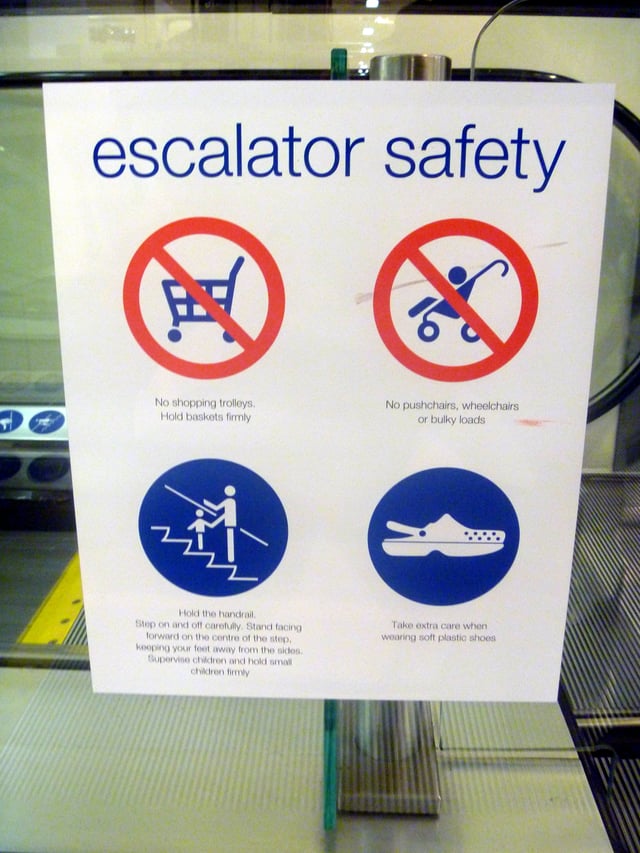
Escalator safety sign warns: Take extra care when wearing soft plastic shoes
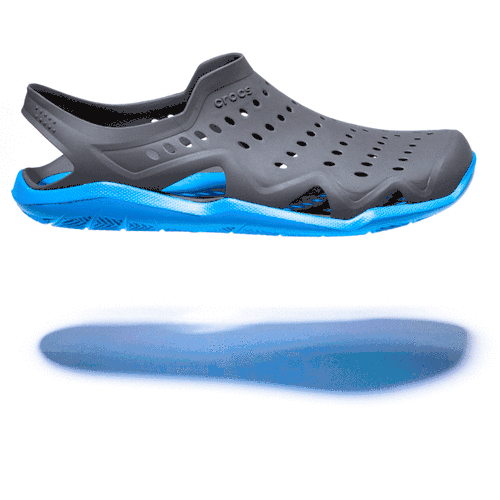
Crocs sandal
Some Crocs shoes were tested and recommended by the U.S.
Ergonomics company in 2005[23] and were accepted by the American Podiatric Medical Association[24] in 2009.[10] In 2008, the U.S. government Centers for Medicare and Medicaid Services approved a model of Crocs with molded insoles as diabetic footwear, to help reduce foot injuries.[25]
Footwear such as Crocs and flip-flops came under scrutiny in 2006 in the U.S. and 2008 in Japan when children suffered injuries after the shoes became caught in escalator mechanisms.[26][27] This was due to the soft shoe material combined with the smaller size of children's feet.[28] In 2008, Japan's Ministry of International Trade and Industry, after receiving 65 complaints of injuries, requested that Crocs change its design.[27]
Internationally, some healthcare facilities introduced policies in 2007 regulating Crocs.
Rapid City Regional Hospital in South Dakota changed its dress code to prohibit the sandal variants and those with holes, citing safety concerns, but allowed closed-top "Professional" and the healthcare-focused "Rx" Crocs to be worn.[29] Over 100 hospitals in Canada were advised to implement similar policies.[30][31] Blekinge and Karolinska University hospitals in Sweden banned the wearing of "Forsberg slippers" (Foppatofflor)[32] by staff, due to high voltage static electricity buildup which was observed[33] to interfere with electronic equipment.[34][35][36] City hospitals in Vienna, Austria announced banning Crocs, often worn by nursing staff, to comply with antistatic requirements.[37]
Crocs announced the Fuse and two others in 2009, formulated to dissipate static electricity in accordance with European standard EN ISO 20347:2004 (E), for use in the medical sector.[38]
Acquisitions
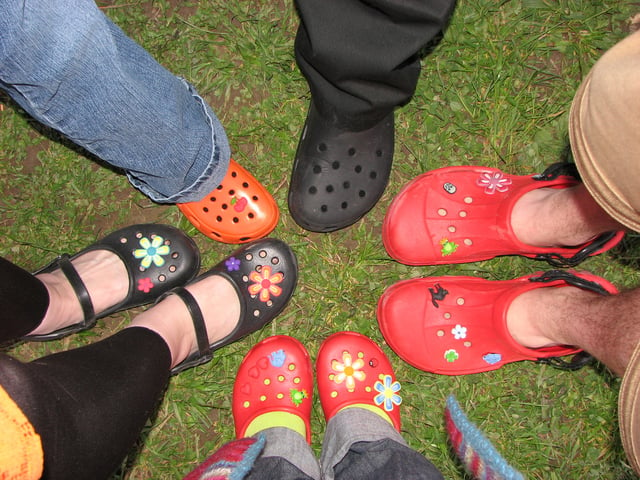
Various types of Crocs with accessories
In October 2006, Crocs Inc. purchased Jibbitz, a manufacturer of accessories that snap into the holes in Crocs shoes, for $10 million, or $20 million if Jibbitz met earnings goals.[39]
In January 2007, Crocs acquired assets of Ocean Minded[40] for $1.75 million in cash, plus potentially $3.75 million based on performance.
Ocean Minded makes leather and ethylene-vinyl acetate-based footwear.[12] In July 2007 Crocs agreed to buy shoe- and sandal-maker Bite Footwear, based in Redmond, Washington for $1.75 million, or up to double that based on earnings results.[41]
In April 2008, Crocs acquired Tidal Trade, Inc. ("Tidal Trade"), the company's third party distributor in South Africa, for $4.6 million.
The company recorded $1.4 million in customer relationships on the date of acquisition.
Crocs repurchased inventory previously sold to Tidal Trade and accordingly recognized a reduction of revenue of approximately $2.1 million.[15] Also in April the company acquired Tagger International B.V.
("Tagger"), a private limited liability company incorporated under Dutch law that manufactures messenger bags. Tagger was partially owned by the Managing Director of Crocs Europe B.V. The company acquired all Tagger assets for $2 million – $90,000 for inventory and $1.9 million for the Tagger trademark.[15] Later in June, Crocs liquidated Fury, Inc. two years after acquiring it,[42] after efforts to sell it off were unsuccessful. As a result, Crocs wrote off $250,000 related to the remaining customer relationships, intangible assets and trademarks over three months.[15]
Influence on fashion and culture

In a 2007 episode of his TV series, comedian Bill Maher stated, "New Rule: Stop wearing plastic shoes."
Starting in 2006, sales of Crocs increased dramatically,[43] with first-quarterly sales roughly tripling from 2006 to 2007, according to The New York Times.[44] An article in The Washington Post described the phenomenon: "Nor is the fashion world enamored of Crocs. Though their maker touts their 'ultra-hip Italian styling,' lots of folks find them hideous."[10] Tim Gunn, fashion consultant, told Time magazine, "... the Croc – it looks like a plastic hoof. How can you take that seriously?"[45] A 2008 anti-Crocs essay by Steve Tuttle in Newsweek [46] generated much response from readers who both agreed and disagreed with it.[47]
In 2007, then-President George W. Bush wore black Crocs with socks publicly.[48] In August 2009, First Lady Michelle Obama was spotted wearing Crocs with her daughter.[49] On June 14, 2015, 23-month-old Prince George, son of Prince William and Kate Middleton, was photographed at a charity event wearing navy blue crocs. After one week, this created a 1,500 percent increase of sales, according to an Amazon.com spokesperson.[50][51]
The shoes have been targets of satire: on Real Time with Bill Maher, Maher called for a "New rule: stop wearing plastic shoes,"[54] and The Daily Show "Senior Public Restroom Correspondent" Rob Corddry, following up on the Senator Larry Craig June 2007 lewd conduct arrest, "reported" that anyone wearing Crocs is signalling "anything goes".[55]
A blog named IHateCrocs.com was founded by two Canadian college students (one, Kate Leth, referred to the shoes as "hideous"), while the website CrocFans.com documents uses of the shoes.[44] The Facebook group, I Don't Care How Comfortable Crocs Are, You Look Like a Dumbass, has been mentioned in the media.[56][57][58]
Stock
Crocs completed the initial public offering of its common stock in February 2006.
It began trading on the NASDAQ Stock Market under the symbol CROX.
On October 30, 2007, the stock dropped 24% when the company announced decreased revenue projections.[61] On April 14, 2008, during the midst of the financial crisis of 2007–2008, the stock dropped 30% in after-hours trading after the company issued a press release in which they significantly decreased earnings estimates for the first quarter. In the same statement they also said they would lay off its 600 Quebec City factory employees as retailers have been reducing orders, though about 100 sales and marketing positions would remain. "The retail environment in the U.S. has become increasingly challenging as consumer spending and traffic levels have slowed," chief executive officer Ron Snyder said. During the financial crisis, CROX dropped to as low as $0.79 before rebounding ($15.50 by November 2010).[62] On October 18, 2011, Crocs stock suffered a single day drop of about 39.4% on lowered earnings and revenues forecast.[63]
In June 2013, Crocs reported a 42.5% decrease in net profits from a year before.
As a result, the stock fell 20.2% in one day.[64]
In December 2013, embattled hedge fund SAC Capital Advisors has disclosed a 5% stake in footwear manufacturer Crocs just over a day after The Blackstone Group said it would invest $200 million in a convertible preferred stock offering that will allow the company to replace its CEO and buy back $350 million in stock.
SAC Capital management said in a filing with the Securities and Exchange Commission it had accumulated a 5% passive stake in Crocs.[65]
Restructuring
On 21 July 2014, Crocs, Inc. announced a restructuring plan to streamline its operations and workforce by eliminating 180 jobs, close 75 to 100 stores (out of 624 worldwide) as well as scrapping underperforming product lines.
Crocs has previously eliminated 183 positions, including 70 current and planned positions in its corporate headquarters in Niwot, Colorado.
Crocs also announced they would open a "global commercial center" with 50 to 75 employees in Boston, Massachusetts in 2014, for merchandising, marketing and retail functions.[66] In August 2018 Crocs announced it was closing its last company-operated manufacturing plants in Mexico and Italy.[67]